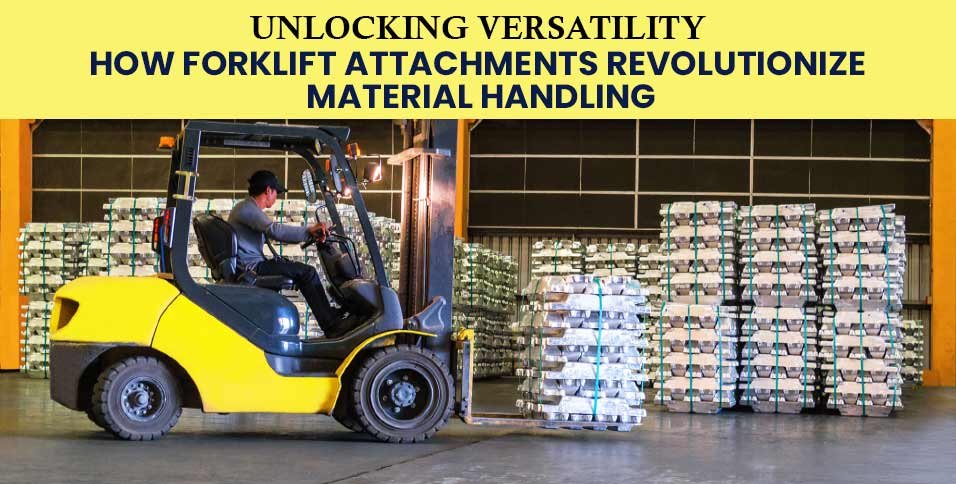Forklifts are indispensable tools in various industries, serving as workhorses for material handling operations. From warehouses to construction sites, these machines streamline the movement of goods and materials, contributing to the efficiency and productivity of businesses worldwide. However, what truly unlocks the potential of forklifts is their adaptability through the use of attachments. These attachments revolutionize material handling by expanding the capabilities of forklifts, enabling them to perform a diverse range of tasks with precision and ease. But before you shop for forklift attachments at Helmar or other reliable sources, here’s a look at how forklift attachments revolutionize material handling, unlocking versatility and efficiency in various industries.
Understanding the Role of Forklift Attachments
At its core, a forklift attachment is a specialized tool designed to be affixed to a forklift, enhancing its functionality for specific tasks. These attachments come in various forms, each tailored to address specific material handling challenges. Whether it’s lifting, rotating, clamping, or carrying unconventional loads, there’s an attachment available to meet virtually any need. With attachments like hydraulic rotators and fork positioners, forklifts can handle delicate items with utmost care and precision, expanding their utility beyond traditional lifting tasks.
Precise Engineering and Design Considerations
Forklift attachments undergo meticulous engineering and design processes to ensure seamless integration with forklifts while maintaining optimal performance and safety standards. Factors such as weight distribution, hydraulic system compatibility, and structural integrity are carefully evaluated during the design phase.
Engineers utilize advanced CAD (Computer-Aided Design) software to model attachment configurations and conduct stress analysis to identify potential weak points or areas of strain. Considerations for ergonomic design are paramount to minimize operator fatigue and maximize efficiency during prolonged usage.
Hydraulic Systems and Control Mechanisms
Many forklift attachments rely on hydraulic systems for operation, necessitating precise control mechanisms to manipulate attachment functions effectively. Hydraulic valves, cylinders, and pumps are intricately integrated into the attachment’s framework, enabling smooth and responsive movement.
Control interfaces, such as joysticks or levers in the operator cabin, provide operators with intuitive control over attachment functions, allowing for precise adjustments during material handling tasks. Furthermore, advanced attachments may feature electronic sensors and feedback systems to monitor load weight, pressure, and positioning, enhancing operational accuracy and safety.
Enhancing Efficiency and Productivity
The integration of forklift attachments significantly boosts efficiency and productivity in material handling operations. Tasks that once required manual labour or multiple machines can now be accomplished swiftly and with minimal effort. For example, a side-shift attachment allows operators to adjust the position of forks laterally, enabling precise alignment during loading and unloading processes.
Similarly, a telescopic boom attachment extends the reach of a forklift, facilitating the handling of loads in confined spaces or at elevated heights. By streamlining processes and minimizing manual intervention, forklift attachments help businesses achieve higher throughput and operational efficiency.
Versatility in Material Handling Operations
One of the most significant advantages of forklift attachments is their versatility. With the right attachments, a single forklift can perform an array of tasks, eliminating the need for multiple specialized machines. This versatility not only saves space and resources but also enhances operational flexibility.
From pallet handling and container stacking to bulk material handling and specialized lifting, forklift attachments empower businesses to adapt to evolving demands efficiently. The versatility offered by attachments enables businesses to explore new opportunities and expand their service offerings, further driving growth and profitability.
Factors to Consider When Choosing Forklift Attachments
Selecting the appropriate forklift attachment is crucial to maximizing its utility and ensuring operational success. Several factors should be taken into account when evaluating potential attachments:
Assessing Your Specific Needs: Identify the primary tasks and challenges in your material handling operations. Consider factors such as load types, sizes, and weights, as well as operational environments and space constraints. By understanding your unique requirements, you can choose attachments that align with your operational goals and objectives.
Safety Considerations: Safety should always be a top priority when choosing forklift attachments. Ensure that the selected attachments comply with relevant safety standards and regulations. Provide adequate training for operators to safely use and maintain the attachments. Investing in safety measures not only protects personnel and equipment but also minimizes the risk of accidents and costly downtime.
Maintenance and Training Requirements: Different attachments may have varying maintenance needs and operational requirements. Evaluate the maintenance schedules, training programs, and support services offered by attachment suppliers to ensure seamless integration into your operations. By investing in regular maintenance and comprehensive training, you can prolong the lifespan of your attachments and optimize their performance over time.
Deciding to shop for forklift attachments at Helmar or similar reliable suppliers is an excellent idea because they play a pivotal role in revolutionizing material handling operations. By expanding the capabilities of forklifts, these attachments enable businesses to achieve higher levels of efficiency, productivity, and versatility. When selecting forklift attachments, careful consideration of specific needs, safety requirements, and long-term benefits is essential. With the right attachments in place, businesses can unlock the full potential of their forklifts and propel their material handling operations to new heights of success.
Also Read: The Role of Forklifts in Construction and Outdoor Work















